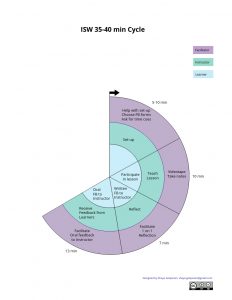Author Archives: shayagol
Connecting Day 1 Sessions
In the April (8,15, 16) ISW, we introduced the day 1 theme sessions as a single theme session on Lesson Design (Theory). We created a worksheet that the participants used during the 4 parts of the lesson (LO; Motivation; PL; Assessment). During each part, they were asked a couple of questions on the worksheet that got them to apply the lesson to the design of their first mini-lesson. At the end of all 4 parts they had 10-15 minutes to look at their mini-lesson and make changes to it based on their worksheet.
This worked well on a couple of levels:
- It connected the 4 theme sessions we do on day 1 without the facilitators having to design them together.
- And it helped our participants solidify what they were learning by providing them with an opportunity for an immediate application of their learning (on which they also received feedback in the afternoon).
If you are interested to know more, send myself, Mabel or Linda an e-mail or stop by the office:-)
Ice breaker!
All My Neighbors
This could be a good large group ice breaker.
from the Cornell Trainer Network Icebreaker-Mini Conference held on July 2nd, 1996
This game is a distant cousin to “musical chairs”. Everyone begins by sitting on chairs in a circle with the facilitator standing in the middle. Facilitator explains that the person in the middle needs to find some “neighbors”. To do so, they’ll make a true statement about themselves and hope that it will be true for others. Everyone that “identifies” with the statement has to then stand up and go to the middle of the circle. When facilitator indicates (using chimes, etc.) everyone who is standing in the centre needs to find an empty chair and sit. This means that someone will be without a chair, and they get to go to the middle and find some “neighbors.”
After giving the above instructions, the facilitator begins with something like: “All my neighbors wearing blue jeans”. At this, everyone who is wearing jeans should jump out of their seats and go to the centre. When facilitator indicates, everyone in the centre will look for an empty seat. The odd person outgoes to the middle. And so on!
This game can easily last ten to fifteen minutes.
Cards
Small Group wrap-up activity:
On day three take a picture with your small group. Have everyone write in blank cards for each other and write their addresses on the envelopes. Later, print the group picture, paste on the card and send out to everyone. That way, you will also have a card with a picture of your small group 🙂
ISW Cycle
Energizer
Clean Up Your Room
For Small Group
Props needed: Soft objects to throw – at least one per participant and a way to mark 2 halves area used for the activity
Form two groups facing one another in a line. Draw an imaginary line in the center. Give each person at least one soft object to throw. Explain the imaginary line is the center of the room and they are responsible for keeping their side of the room clean by throwing all objects to the other side.
When the sound is made time is up and the side with the “cleanest room” wins.
Grad Team Principles: Living Conversation
Our team is undergoing a process of re-articulating its guiding principles, and this is a process we would like to engage in through conversation with our whole team. Joseph, Jason and I will each be initiating a conversation in this blog about one of the principles we came up with in an initial conversation. Please comment, or start a new post to share your own thoughts, respond to what you’ve seen others say, or just reflect. We will read what you write, and the eventual statements of our principles will grow from the conversation we have here.
Living Conversation
The work that we do in our roles as members of the Grad Team at CTLT, relies a lot on the concept of a “living” conversation. By conversation we mean as much a conversation with others as a conversation with contextual (physical, inter-cultural, social, pedagogical, etc.) spaces, theories, practices, meanings, processes and applications.
A “living” conversation is a conversation that both breathes and listens, where knowledge creation and understanding take place on-goingly and through the acts of theorizing as a process of complication – The kind of theorizing that takes place in relational, practical and creative ways of making meaning through recursive, reflective, responsive forms of engagement. A “living” conversation means that we do not engage in and/or interact with others, spaces, knowledge, etc., with a non-flexible and predetermined agenda.
Both in the work we do as Educational program developers and as facilitators we enter all forms of conversation with an open mind, we engage in constant questioning of our assumptions and processes, and redirect, redesign, and realign our paths. A “living” conversation also implies that the work we do carries on beyond our involvement with it into other spaces and conversations. It echoes beyond the work that we do and takes on a life of its own.
How do you relate to this definition of a “living” conversation? How would you define it in the work that you do? And how does it impact your work?
